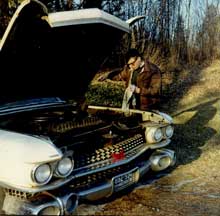I’ve owned 40-some cars in my lifetime, but only one Cadillac. In the summer of 1967, in a misguided fit of youthful enthusiasm, I bought a boat. Since my Austin-Healey Sprite was an inappropriate tow car, I looked around for something heftier. After considering a 1955 Cadillac, a 1960 Lincoln and the car I should have bought, a low-mileage 1957 Buick, I settled for a 1959 Cadillac Sedan de Ville.
Henry Martyn Leland (seen here with “Osceola,” his 1905 coupe) was the father of Cadillac and the “Master of Precision.” He developed exacting standards for machine work at Brown & Sharpe, then went to Detroit to build engines for the new motor trade. Leland’s Cadillacs were so precisely built that in 1908 three Model K cars were disassembled, their parts scrambled, then three cars built from the mixture, all of which started and ran. This earned Cadillac the Royal Automobile Club’s Dewar Trophy and the title “Standard of the World.”
By 1914, Cadillac was a large car, still with four cylinders but with electric starting and lighting. By 1923, closed cars were the norm and V8s ruled. As the Depression raged, Cadillac threw caution to the winds and introduced not just V-12s but also V-16s. In 1938, a young designer named Harley Earl penned the Sixty Special, a design icon to this day. Cadillac grew heftier in 1941, and after the war started the tailfin craze, and while the Fleetwood limos were anachronistic the fastback Sedanettes were positively beguiling.
It wasn’t until 1950 that Cadillac surpassed Packard for good as top-selling American luxury car, but from that time Caddy never looked back, though by 1952 the cars were a bit overbearing. Finer lines in 1954 improved the looks, and by 1957 the Cadillacs were low and lithe, the top-of-the-line Eldorado Brougham selling for a cool $13,500.
My ’59 was a camp caricature of a car, one of the reasons I bought it. The fins had grown to grotesque proportions by 1959 and the engine was now a 390 cubic inch behemoth. Mine was the four-window “flat top” style, rather than the more attractive six-window design, and had add-on air and gold lamé upholstery. It headstrong on snowy roads and several pairs of skis would fit in the trunk. The previous owner said it would run on Gulftane, Gulf’s cheap low-octane brand (it didn’t), and with 130,000 miles on the clock it needed lots of TLC, which included regularly checking the oil.
One Sunday evening I returned home from a weekend of skiing. The transmission had been shifting erratically and I nursed it the last 50 miles. I pulled into the driveway, shifted to reverse to turn it around and my Caddy didn’t move. My Hydra-Matic had “Park” and five “Neutrals.” The next day I took off as many saleable parts as I could and called the local scrapyard. I had owned the car for three months and it had cost me, including the purchase price, $300. For $100 a month, I reckoned, I could have a new car. I bought a showroom-fresh Volvo 122S.

